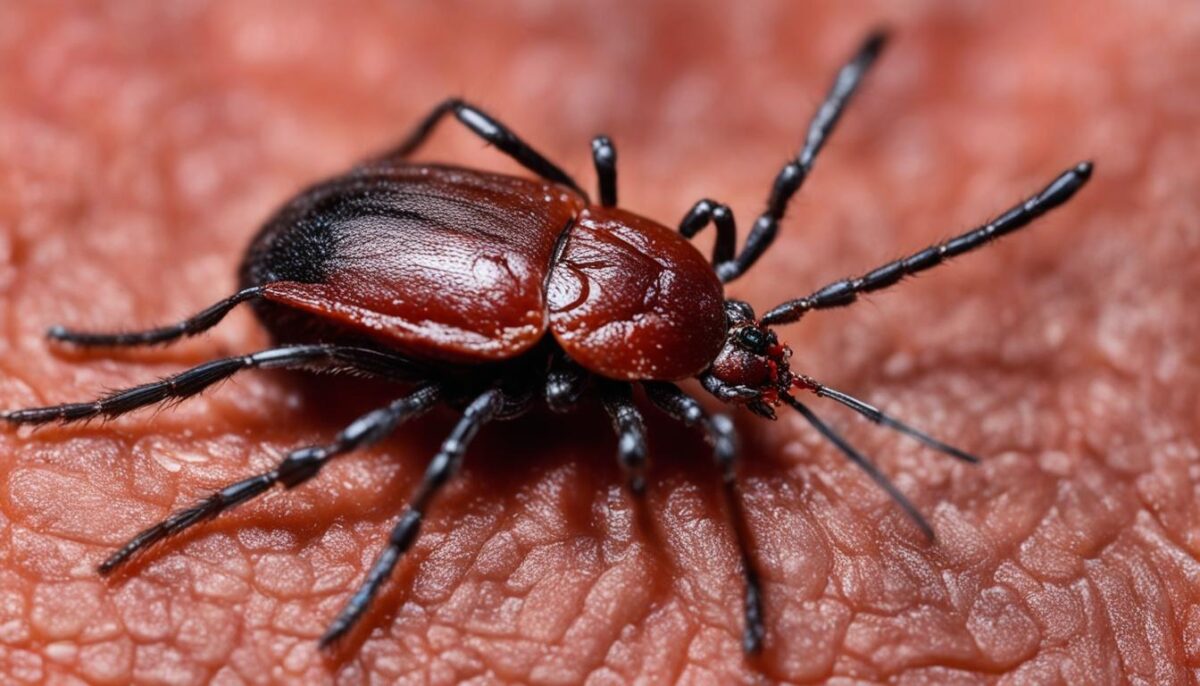Tularemia, also known as “rabbit fever,” is a disease caused by the bacterium Francisella tularensis. This infectious disease is primarily found in animals, particularly rodents, rabbits, and hares. While it rarely affects humans, tularemia can have serious consequences if not treated promptly. Let’s explore the risks associated with tularemia and understand how to protect ourselves.
Key Takeaways:
- Tularemia, or rabbit fever, is caused by the bacterium Francisella tularensis.
- It is primarily found in animals, such as rodents, rabbits, and hares.
- People can become infected through various routes, including insect bites, handling infected animals, consuming contaminated food or water, or inhaling airborne bacteria.
- Tularemia can lead to serious health complications if not treated with appropriate antibiotics.
- Understanding the symptoms, modes of transmission, diagnosis, treatment, and prevention measures is crucial in minimizing the risks associated with tularemia.
How is Tularemia Transmitted and What are the Symptoms?
Tularemia, also known as rabbit fever, can be transmitted through various means, including:
- Tick and deerfly bites: These insects can carry the bacteria responsible for tularemia and transmit it to humans through their bites.
- Handling infected animals: Sick or dead animals, particularly rodents, rabbits, and hares, can carry the bacteria. Direct contact with their tissues or bodily fluids can lead to transmission.
- Consuming contaminated food or water: Tularemia bacteria can contaminate food and water sources, leading to infection if ingested.
- Inhaling airborne bacteria: In some cases, the bacteria can become aerosolized, allowing it to enter the respiratory system and cause infection.
The symptoms of tularemia can vary depending on the mode of transmission. Common symptoms include:
- Skin ulcers: Infected individuals may develop painful ulcers at the site of infection, such as on the skin or mucous membranes.
- Swollen lymph glands: Inflammation and swelling of the lymph nodes are common symptoms of tularemia.
- Inflamed eyes: Conjunctivitis, or pink eye, can occur in some cases of tularemia.
- Sore throat and mouth sores: Irritation in the throat and the appearance of mouth sores are potential symptoms of tularemia.
- Diarrhea: Some individuals with tularemia may experience gastrointestinal symptoms, including diarrhea.
- Pneumonia and respiratory failure: In severe cases, tularemia can lead to pneumonia and respiratory failure, which can be life-threatening.
The incubation period for tularemia typically ranges from 1 to 14 days, with most individuals developing symptoms within 3 to 5 days after exposure. If you experience any of these symptoms after potential exposure to tularemia, it is important to seek medical attention for diagnosis and treatment.

Diagnosis, Treatment, and Prevention of Tularemia
Tularemia, also known as “rabbit fever,” is a serious disease caused by the bacterium Francisella tularensis. Prompt diagnosis, appropriate treatment, and preventive measures are crucial in managing and preventing the spread of tularemia.
Diagnosis of Tularemia
The diagnosis of tularemia involves laboratory testing of specimens such as blood or sputum. Through these tests, healthcare professionals can identify the presence of Francisella tularensis bacteria in the body.
Presumptive identification of tularemia can be done in less than 2 hours using techniques like polymerase chain reaction (PCR), while confirmatory testing may take longer, typically involving cultivation and isolation of the bacteria.
Treatment of Tularemia
Early antibiotic treatment is essential in managing tularemia and preventing complications. Several types of antibiotics have been found to be effective against tularemia, including:
- Doxycycline
- Ciprofloxacin
- Streptomycin
- Gentamicin
It’s important to consult a healthcare professional for appropriate diagnosis and prescription of antibiotics in case of suspected tularemia infection.
Prevention of Tularemia
Preventing tularemia involves taking precautionary measures to minimize the risk of exposure to the bacteria. Here are some preventive measures:
- Using insect repellent to protect against insect bites, which can transmit tularemia.
- Regularly washing hands with soap and water, especially after handling animals or being outdoors.
- Cooking food thoroughly to kill any potential bacteria.
- Obtaining water from safe and reliable sources to avoid contamination.
Although there is currently no vaccine available for tularemia in the United States, practicing these preventive measures can significantly reduce the chances of contracting the disease.

Forms of Tularemia and Their Effects on the Body
Tularemia, also known as “rabbit fever,” manifests in various forms, each with its own set of symptoms and effects on the body. Understanding these forms is crucial in recognizing and treating the disease appropriately.
The different forms of tularemia include:
- Ulceroglandular tularemia
- Glandular tularemia
- Oculoglandular tularemia
- Oropharyngeal tularemia
- Pneumonic tularemia
- Typhoidal tularemia
Each form of tularemia affects different parts of the body, leading to a range of symptoms and health implications. Here is a breakdown of the effects of tularemia on specific organs:
| Form of Tularemia | Effects on the Body |
|---|---|
| Ulceroglandular Tularemia | Affects the skin and lymph nodes, causing ulcers and swelling. |
| Glandular Tularemia | Primarily affects the lymph nodes, resulting in swelling and tenderness. |
| Oculoglandular Tularemia | Involves the eyes and lymph nodes, leading to eye irritation, redness, and swelling. |
| Oropharyngeal Tularemia | Affects the throat and nearby lymph nodes, causing sore throat, mouth sores, and difficulty swallowing. |
| Pneumonic Tularemia | Targets the lungs, resulting in pneumonia-like symptoms, including cough, chest pain, and difficulty breathing. |
| Typhoidal Tularemia | Can affect multiple organs, including the lymph nodes, liver, spleen, and intestines, causing systemic symptoms such as fever, fatigue, and abdominal pain. |
In severe cases, tularemia can lead to inflammation in any organ, including the brain and heart. The effects of tularemia can range from mild discomfort to life-threatening complications depending on the form and the individual’s overall health.
 Illustration: Different forms of tularemia and their effects on the body
Illustration: Different forms of tularemia and their effects on the body
Can Tularemia Be Used as a Bioweapon?
Tularemia, a highly infectious disease caused by the bacterium Francisella tularensis, has raised concerns regarding its potential as a bioweapon. The bacterium is so potent that even a small number of organisms, ranging from 10 to 50, can cause the disease in individuals exposed to it. If tularemia were to be utilized as a bioweapon, it is likely that the bacteria would be engineered to become airborne, enhancing its transmissibility through inhalation.
Inhaling the bacteria behind tularemia can have severe consequences for the respiratory system, leading to life-threatening pneumonia and systemic infection. The infectious capability of tularemia makes it a potential threat in a bioweapons context, as it can rapidly spread through an exposed population, causing widespread illness and potential fatalities.
However, manufacturing an effective aerosol weapon using tularemia as a bioweapon would require considerable sophistication. The process of engineering the bacteria to be suitable for aerosol use necessitates specialized knowledge and resources, making it a challenging endeavor for potential perpetrators.
Using Tularemia as a Bioweapon: Challenges and Limitations
Several factors contribute to the complexity of using tularemia as a bioweapon:
- Viability of airborne transmission: While tularemia can be made aerosolized, ensuring the bacteria stay stable and infectious during dispersal and remain capable of causing disease poses significant challenges.
- Manufacturing expertise: Developing an effective aerosol weapon using tularemia necessitates a high level of scientific knowledge and technical capability, limiting the number of entities capable of successfully producing such a weapon.
- Weapon dissemination: Disseminating the weaponized tularemia over a targeted area while ensuring adequate concentration and exposure to cause infection poses logistical challenges.
- Potential for unintended consequences: Employing tularemia as a bioweapon carries the risk of unintended consequences, including accidental exposure to the population dispersing the weapon, leading to outbreaks beyond the intended target.
In conclusion, while tularemia’s highly infectious nature makes it a concern as a potential bioweapon, the process of manufacturing an effective aerosol weapon using the bacteria requires considerable sophistication and expertise. Understanding the challenges and limitations involved in utilizing tularemia as a bioweapon is crucial for assessing the overall risk and potential impact on public health and safety.
Conclusion
Tularemia, also known as rabbit fever, is a serious disease caused by the bacterium Francisella tularensis. While it can be potentially fatal if not treated, early diagnosis and appropriate antibiotic treatment can effectively manage the infection.
Understanding the transmission, symptoms, diagnosis, treatment, and prevention of tularemia is crucial in protecting oneself from this disease. By taking necessary precautions, such as using insect repellent, washing hands regularly, and cooking food thoroughly, the risks of tularemia can be minimized. In case of any potential exposure or symptoms, seeking prompt medical attention is essential to prevent severe complications.
Stay informed about tularemia and prioritize your health and safety. Remember, with timely intervention and proper medical care, the risks associated with tularemia can be mitigated. Take the necessary steps to protect yourself and prevent potential fatalities.
FAQ
What is tularemia?
Tularemia, also known as “rabbit fever,” is a disease caused by the bacterium Francisella tularensis. It is typically found in animals, especially rodents, rabbits, and hares.
How is tularemia transmitted?
Tularemia can be transmitted through the bite of infected insects, such as ticks and deerflies, handling infected sick or dead animals, consuming contaminated food or water, or inhaling airborne bacteria.
What are the symptoms of tularemia?
The symptoms of tularemia vary depending on the mode of transmission and can include skin ulcers, swollen lymph glands, inflamed eyes, sore throat, mouth sores, diarrhea, pneumonia, and respiratory failure.
How is tularemia diagnosed?
Tularemia can be diagnosed through laboratory testing of specimens such as blood or sputum. Presumptive identification of tularemia can be done in less than 2 hours, while confirmatory testing may take longer.
How is tularemia treated?
Early antibiotic treatment is recommended for tularemia, with several types of antibiotics found to be effective, including doxycycline, ciprofloxacin, streptomycin, and gentamicin.
How can tularemia be prevented?
Prevention measures include using insect repellent, washing hands regularly, cooking food thoroughly, and obtaining water from safe sources.
What are the different forms of tularemia?
Tularemia has several forms, including ulceroglandular tularemia, glandular tularemia, oculoglandular tularemia, oropharyngeal tularemia, pneumonic tularemia, and typhoidal tularemia, each affecting different parts of the body.
Can tularemia be used as a bioweapon?
Tularemia is of concern as a potential bioweapon due to its highly infectious nature. While it occurs naturally, manufacturing an effective aerosol weapon using the bacteria would require considerable sophistication.


